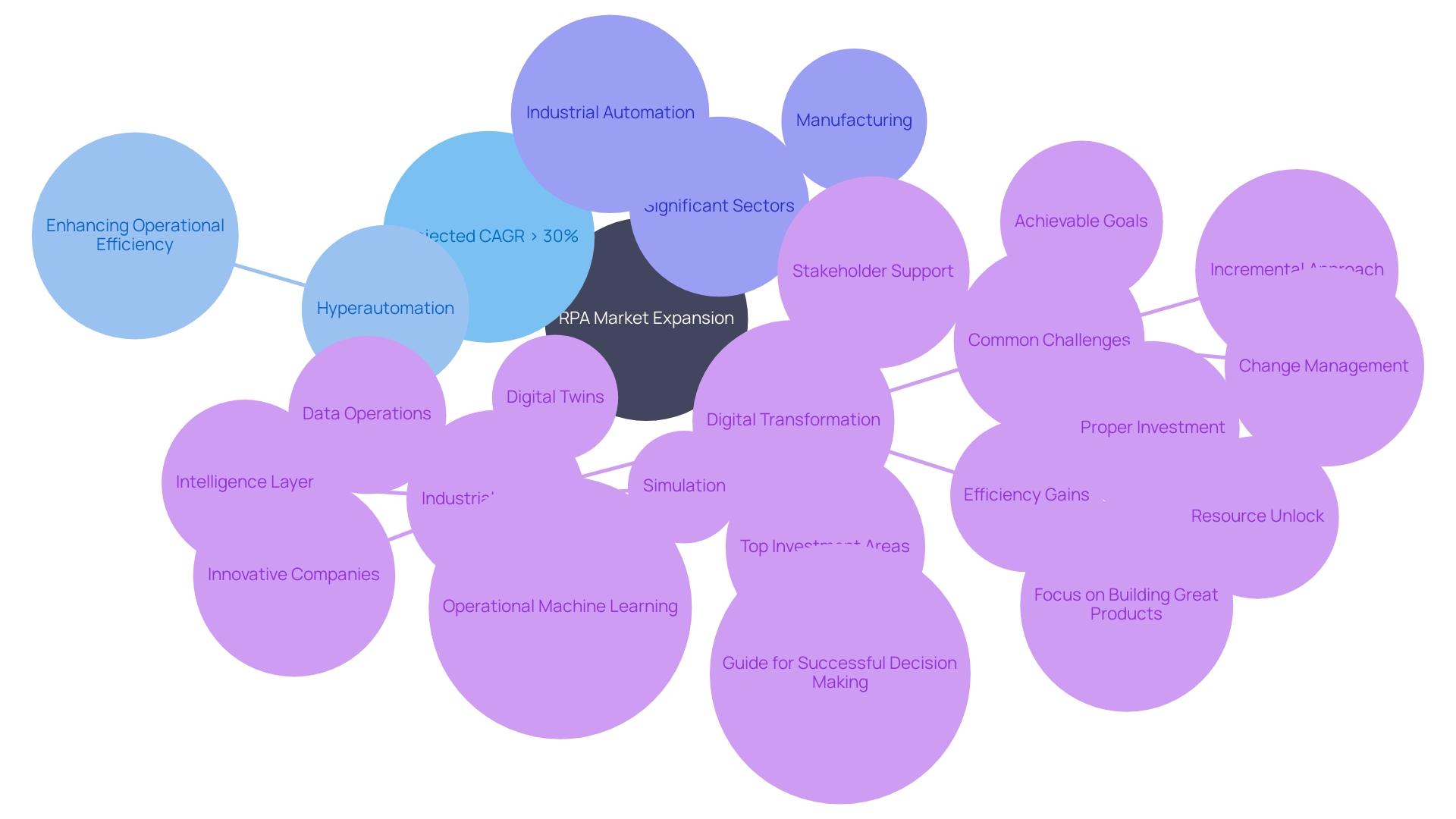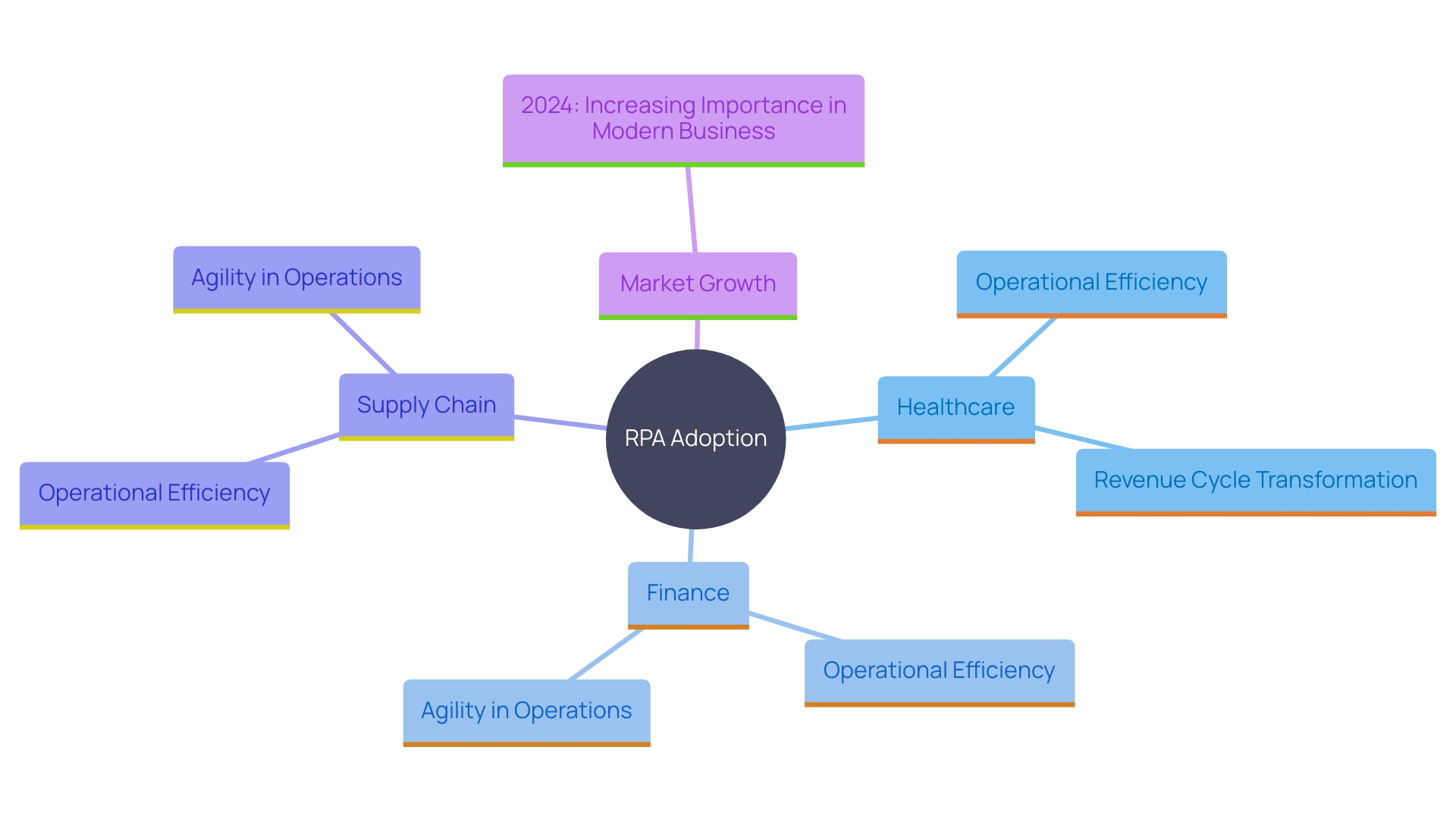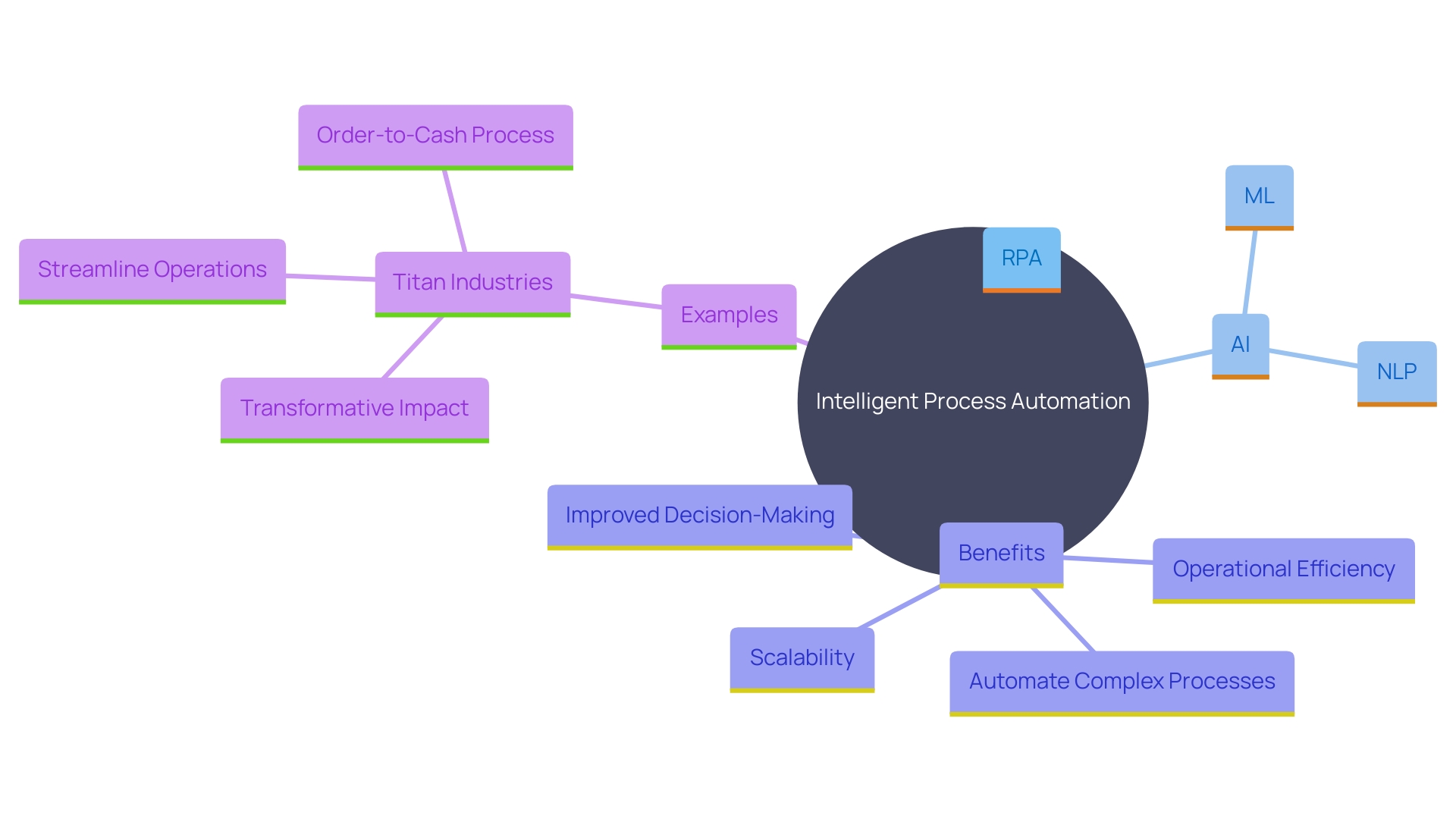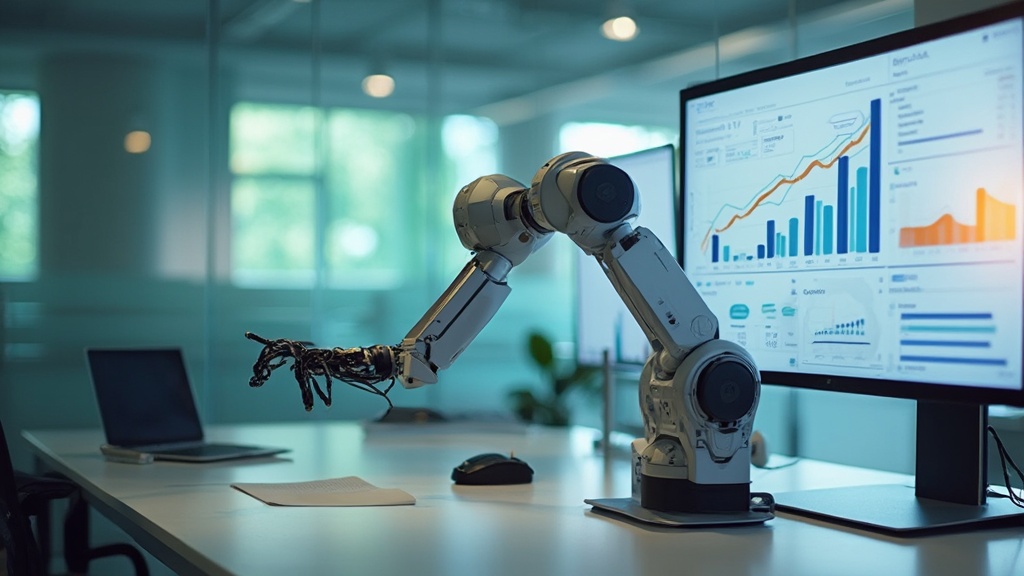Introduction
The Robotic Process Automation (RPA) market is witnessing unprecedented expansion, driven by the escalating demand for automation solutions across diverse industries. Predictions indicate a remarkable annual growth rate exceeding 30%, as companies seek to enhance operational efficiency, cut costs, and improve accuracy. The advent of hyperautomation, integrating RPA with AI, has further revolutionized the landscape, enabling the automation of complex tasks that previously required extensive manual intervention.
This transformative technology is set to bolster the industrial automation sector, which is projected to grow significantly in the coming years.
Moreover, the COVID-19 pandemic has accelerated RPA adoption, highlighting its resilience and flexibility in maintaining business continuity. Sectors such as healthcare, finance, and supply chain management have particularly benefited, with RPA streamlining operations and enhancing agility in response to disruptions. The rise of Intelligent Process Automation (IPA), combining RPA with advanced AI technologies, is enabling businesses to automate intricate processes, thereby driving productivity and innovation.
As RPA tools proliferate, establishing robust governance and standardization frameworks becomes crucial. Companies are increasingly prioritizing the creation of comprehensive guidelines to ensure compliance, mitigate risks, and optimize performance. This strategic approach to RPA governance is essential for sustaining growth and maximizing the benefits of automation in the evolving digital landscape.
RPA Market Expansion: Forecasts and Predictions
The Robotic Process Automation (RPA) market is on the verge of substantial expansion, driven by the rising need for mechanized solutions across different sectors. Analysts project a soaring compound annual growth rate (CAGR) of over 30% for the global RPA market. This surge is driven by organizations striving to enhance operational efficiency, reduce costs, and improve accuracy in their processes.
The integration of RPA with AI technology, referred to as hyperautomation, has transformed the landscape of automated processes. This mixture of mechanized functions tackles the complexity and variability of tasks, such as invoice analysis, which previously posed challenges. Hyperautomation’s ability to handle diverse document variations without extensive pre-programming exemplifies its transformative potential.
Supporting this trend, the industrial automation sector is experiencing substantial expansion, with forecasts predicting a 9.3% annual increase, reaching £227.6bn by 2030. This increase is fueled by advancements in technology and heightened demand across multiple sectors, including manufacturing, oil and gas, and power generation. The manufacturing sector alone accounts for over 30% of the market, driven by the need for operational resilience and supply chain stability amidst geopolitical tensions.
Robert McElmurry, Director of Business Intelligence at the Association for Advancing Automation (A3), emphasizes the importance of RPA and hyperautomation in the broader context of digital transformation. He notes, ‘As businesses continue to embrace digital transformation, RPA will play a crucial role in automating repetitive tasks and streamlining workflows.’
In conclusion, the RPA market’s exponential growth, coupled with the innovative potential of hyper automation, positions it as a pivotal force in the ongoing evolution of industrial automation. This transformation not only enhances efficiency but also aligns with global efforts toward operational resilience and sustainability.

Impact of COVID-19 on RPA Adoption
The COVID-19 pandemic has sped up the adoption of Robotic Process Management (RPA) as organizations sought to adjust to remote work and maintain business continuity. Companies that had already integrated RPA solutions were better positioned to pivot during the crisis, showcasing the technology’s resilience and flexibility. This shift has opened new avenues for RPA deployment across various sectors, including healthcare, finance, and supply chain management.
For instance, in the healthcare sector, the integration of RPA has been pivotal. Companies like Ambience have leveraged partnerships to boost their products to new heights by enhancing interoperability and data integration with healthcare systems. This rapid adoption, sometimes within just two to six weeks, has underscored the importance of RPA in improving operational efficiency and reducing the time required for system integration.
In finance, RPA has transformed the revenue cycle by automating routine tasks, allowing staff to focus on more strategic initiatives. Amy Raymond, Senior Vice President of Revenue Cycle Operations at AKASA, emphasizes, “The use of technology is no longer simply an option in the revenue cycle — it is an imperative.” These technologies drive significant improvements in revenue yield, cost reduction, and staff efficiency.
The supply chain sector has also seen significant advancements with RPA. The use of technology has allowed companies to streamline operations, enhance agility, and respond more effectively to disruptions. As organizations continue to prioritize RPA investments, they build more agile operations capable of withstanding future disruptions, ensuring a robust and resilient business model.
The market for robotic operating systems is expected to grow significantly, with projections indicating a rise from $534.2 million in 2022 to $1.8 billion by 2032. This growth highlights the increasing recognition of RPA’s value across various industries, further solidifying its role as a critical component in modern business operations.

Rise of Intelligent Process Automation (IPA)
As organizations work to improve their mechanization capabilities, the emergence of Intelligent Process Automation (IPA) is becoming more and more important. IPA merges Robotic Process Automation (RPA) with advanced technologies like artificial intelligence, machine learning, and natural language processing. This powerful combination enables more complex decision-making and sophisticated data analysis, allowing businesses to automate not only repetitive tasks but also intricate processes.
For instance, Titan Industries used IPA to streamline their order-to-cash process by addressing credit blocks. By integrating AI-powered solutions, they accelerated decision-making and reduced delays in order fulfillment, particularly for reliable customers. This example underscores how IPA can resolve bottlenecks, enhancing operational efficiency and customer satisfaction.
Furthermore, IPA’s scalability is evident in scenarios where manual data extraction from thousands of documents was automated, freeing employees to focus on more creative and impactful work. This not only improved productivity but also demonstrated how the same AI models could be applied across various business units, amplifying the overall value.
The shift towards IPA marks a pivotal evolution in RPA, unlocking greater potential for businesses. It empowers organizations to focus on high-value activities, transforming their operational landscape and positioning them for success in the competitive market. With 83% of companies prioritizing AI in their strategies, the adoption of IPA is poised to drive transformative changes, enhancing efficiency, productivity, and innovation.

RPA Governance and Standardization: A Growing Priority
As RPA tools and implementations continue to expand rapidly, the need for robust governance and standardization becomes increasingly vital for organizations. Establishing clear guidelines and best practices for RPA usage is essential to ensure compliance, mitigate risks, and optimize performance. Companies are increasingly recognizing the importance of creating a centralized governance framework that encompasses RPA strategy, tool selection, and performance monitoring. According to Blake Jensen, SVP of Quality Assurance at HUYABIO International, companies are exploring risk assessment approaches that enable them to be more efficient and keep up with technology advancements, which aligns with the necessity for a comprehensive governance framework. Additionally, good data governance practices can significantly improve the day-to-day operations, efficiency, and effectiveness of a team or program, as demonstrated by the internal WWT project, the RFP Assistant. This focus on governance will help organizations maximize the benefits of RPA while minimizing potential pitfalls, ensuring sustainable growth in their automation journey.
Conclusion
The Robotic Process Automation (RPA) market is set for substantial growth, with projections indicating an annual increase of over 30%. Organizations are embracing RPA to improve operational efficiency and reduce costs. The combination of RPA with artificial intelligence, known as hyperautomation, is revolutionizing the automation landscape by enabling the handling of complex tasks that were previously labor-intensive.
The COVID-19 pandemic has accelerated the adoption of RPA, as businesses sought solutions to maintain continuity and adapt to remote work. Key sectors, including healthcare, finance, and supply chain management, have leveraged RPA to enhance operational agility and streamline processes in response to disruptions.
Moreover, the rise of Intelligent Process Automation (IPA) further enhances the capabilities of RPA by integrating advanced technologies such as machine learning and natural language processing. This allows organizations to automate not only repetitive tasks but also more complex processes, fostering innovation and productivity.
To maximize the benefits of RPA and IPA, establishing strong governance and standardization is critical. Implementing clear guidelines and best practices ensures compliance, mitigates risks, and optimizes performance. A robust governance framework will enable organizations to navigate the complexities of the digital landscape effectively.
By prioritizing these strategies, businesses can achieve sustainable growth and thrive in an increasingly competitive environment.

